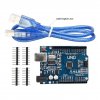Pantsignal
- Feb 26, 2016
- 6
- Joined
- Feb 26, 2016
- Messages
- 6
Hi
I am still very new to embedded systems and the such, I am learning basics on an Arduino UNO.
I am getting eager to try and create a simple circuit off of the Arduino. I have some board to wire the components too. In fact I have all parts I need except for a microcontroller. I am not sure what I need to but to make a small project, lets say using Blink (blink and LED based on the software uploaded). How would I use a microcontroller on just a plain electronics board (not on the Arduino).
By 'palin board' I mean something like this
https://solarbotics.com/product/20932/
I am still very new to embedded systems and the such, I am learning basics on an Arduino UNO.
I am getting eager to try and create a simple circuit off of the Arduino. I have some board to wire the components too. In fact I have all parts I need except for a microcontroller. I am not sure what I need to but to make a small project, lets say using Blink (blink and LED based on the software uploaded). How would I use a microcontroller on just a plain electronics board (not on the Arduino).
By 'palin board' I mean something like this
https://solarbotics.com/product/20932/

